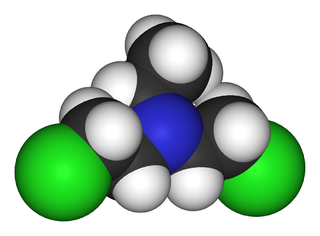
Chemotherapy is a type of cancer treatment that uses one or more anti-cancer drugs as part of a standardized chemotherapy regimen. Chemotherapy may be given with a curative intent or it may aim to prolong life or to reduce symptoms. Chemotherapy is one of the major categories of the medical discipline specifically devoted to pharmacotherapy for cancer, which is called medical oncology.
Mustard gas or sulfur mustard is any of several chemical compounds that contain the chemical structure SCH2CH2Cl. In the wider sense, compounds with the substituent SCH2CH2X and NCH2CH2X are known as sulfur mustards and nitrogen mustards (X = Cl, Br), respectively. Such compounds are potent alkylating agents, which can interfere with several biological processes. Also known as mustard agents, this family of compounds are infamous cytotoxic and blister agents. The name mustard gas is technically incorrect: the substances, when dispersed, are often not gases but a fine mist of liquid droplets. Mustard gases form blisters on exposed skin and in the lungs, often resulting in prolonged illness ending in death. The typical mustard gas is the organosulfur compound called bis(2-chloroethyl) sulfide.

Alkylation is a chemical reaction that entails transfer of an alkyl group. The alkyl group may be transferred as an alkyl carbocation, a free radical, a carbanion, or a carbene. Alkylating agents are reagents for effecting alkylation. Alkyl groups can also be removed in a process known as dealkylation. Alkylating agents are often classified according to their nucleophilic or electrophilic character. In oil refining contexts, alkylation refers to a particular alkylation of isobutane with olefins. For upgrading of petroleum, alkylation produces a premium blending stock for gasoline. In medicine, alkylation of DNA is used in chemotherapy to damage the DNA of cancer cells. Alkylation is accomplished with the class of drugs called alkylating antineoplastic agents.

Chlormethine, also known as mechlorethamine, mustine, HN2, and embikhin (эмбихин), is a nitrogen mustard sold under the brand name Mustargen among others. It is the prototype of alkylating agents, a group of anticancer chemotherapeutic drugs. It works by binding to DNA, crosslinking two strands and preventing cell duplication. It binds to the N7 nitrogen on the DNA base guanine. As the chemical is a blister agent, its use is strongly restricted within the Chemical Weapons Convention where it is classified as a Schedule 1 substance.

Nitrogen mustards are cytotoxic organic compounds with the chloroethylamine ((ClCH2)2NR2) functional group. Although originally produced as chemical warfare agents, they were the first chemotherapeutic agents for treatment of cancer. Nitrogen mustards are nonspecific DNA alkylating agents.

Uramustine (INN) or uracil mustard is a chemotherapy drug which belongs to the class of alkylating agents. It is used in lymphatic malignancies such as non-Hodgkin's lymphoma. It works by damaging DNA, primarily in cancer cells that preferentially take up the uracil due to their need to make nucleic acids during their rapid cycles of cell division. The DNA damage leads to apoptosis of the affected cells. Bone marrow suppression and nausea are the main side effects.

Melphalan, sold under the brand name Alkeran among others, is a chemotherapy medication used to treat multiple myeloma, ovarian cancer, melanoma, and AL amyloidosis. It is taken by mouth or by injection into a vein.

Chlorambucil, sold under the brand name Leukeran among others, is a chemotherapy medication used to treat chronic lymphocytic leukemia (CLL), Hodgkin lymphoma, and non-Hodgkin lymphoma. For CLL it is a preferred treatment. It is given by mouth.

Altretamine, also called hexamethylmelamine, is an antineoplastic agent. It was approved by the U.S. FDA in 1990.

Bis(2-chloroethyl)ethylamine is the organic compound with the formula C2H5N(CH2CH2Cl)2. Often abbreviated HN1, it is a powerful vesicant and a nitrogen mustard gas used for chemical warfare. HN1 was developed in the 1920s and 1930s to remove warts and later as a military agent. Because of the latter use, it is a Schedule 1 chemical within the Chemical Weapons Convention and therefore use and production is strongly restricted. It has never been used in warfare.

Carmustine, sold under the brand name BiCNU among others, is a medication used mainly for chemotherapy. It is a nitrogen mustard β-chloro-nitrosourea compound used as an alkylating agent.
An alkylating antineoplastic agent is an alkylating agent used in cancer treatment that attaches an alkyl group (CnH2n+1) to DNA.

Trofosfamide (INN) is a nitrogen mustard alkylating agent. It is sometimes abbreviated "TRO". It has been used in trials to study its effects on ependymoma, medulloblastoma, sarcoma, soft tissue, supratentorial PNET, and recurrent brain tumors.

Semustine is an alkylating nitrosourea compound used in chemotherapy treatment of various types of tumours. Due to its lipophilic property, semustine can cross the blood-brain barrier for the chemotherapy of brain tumours, where it interferes with the cellular DNA of the highly dividing cells. Semustine, just as lomustine, is administered orally. It has been reported that semustine can perform the main mechanism of action at molecular level via the alkylation of DNA nitrogenous bases in duplex by results of inhibition of DNA replication, transcription, and translation by way of alkylation of DNA, under pH-dependent conditions by hydrolysis, forming chloro-carbonium ions. Sufficient evidence was found that treatment with semustine can cause acute leukaemia as a delayed effect in very rare cases.

Chlornaphazine, a derivative of 2-naphthylamine, is a nitrogen mustard that was developed in the 1950s for the treatment of polycythemia and Hodgkin's disease. However, a high incidence of bladder cancers in patients receiving treatment with chlornaphthazine led to use of the drug being discontinued.

O6-Benzylguanine (O6-BG) is a synthetic derivative of guanine. It is an antineoplastic agent. It exerts its effect by acting as a suicide inhibitor of the enzyme O6-alkylguanine-DNA alkyltransferase which leads to interruption of DNA repair. O6-BG was used clinically in combination with the alkylating agent temozolomide for glioblastoma, however the combination was found to be overly toxic without adding significant benefit.

Alestramustine (INN), also known as estradiol 3-(bis carbamate) 17β-(L-alaninate), is a cytostatic antineoplastic agent which was never marketed. It is the L-alanine ester of estramustine, which is a combination of the nitrogen mustard normustine coupled via a carbamate to the estrogen estradiol. Alestramustine acts as a prodrug to estramustine, and also forms estradiol as a byproduct. The drug, via its active metabolites, binds to microtubule-associated proteins and β-tubulin and interferes with microtubule function, thereby inhibiting cell division. Due to its estrogen moiety, alestramustine is selectively concentrated in estrogen receptor-positive cells such as prostate and breast.
Phenestrol, or fenestrol, also known as hexestrol bis[4-[bis(2-chloroethyl)amino]phenylacetate, is a synthetic, nonsteroidal estrogen and cytostatic antineoplastic agent and a chlorphenacyl nitrogen mustard ester of hexestrol which was developed in the early 1960s for the treatment of hormone-dependent tumors but was never marketed.

Estradiol mustard, also known as chlorphenacyl estradiol diester, as well as estradiol 3,17β-bis(4- phenyl)acetate, is a synthetic, steroidal estrogen and cytostatic antineoplastic agent and a chlorphenacyl nitrogen mustard-coupled estrogen ester that was never marketed. It is selectively distributed into estrogen receptor (ER)-positive tissues such as ER-expressing tumors like those seen in breast and prostate cancers. For this reason, estradiol mustard and other cytostatic-linked estrogens like estramustine phosphate have reduced toxicity relative to non-linked nitrogen mustard cytostatic antineoplastic agents. However, they may stimulate breast tumor growth due to their inherent estrogenic activity and are said to be devoid of major therapeutic efficacy in breast cancer, although estramustine phosphate has been approved for and is used in the treatment of prostate cancer.

Normustine, also known as bis(2-chloroethyl)carbamic acid, is a nitrogen mustard and alkylating antineoplastic agent. It is a metabolite of a number of antineoplastic agents that have been developed for the treatment of tumors, including estramustine phosphate, alestramustine, cytestrol acetate, and ICI-85966 (stilbostat), but only the former of which has actually been marketed.

















